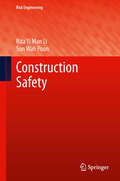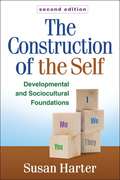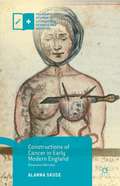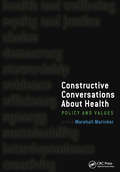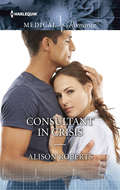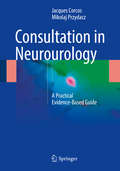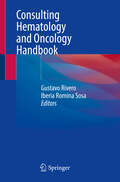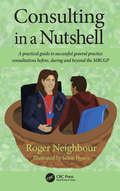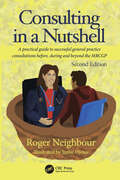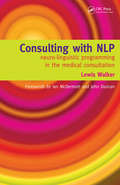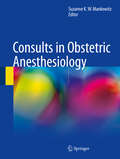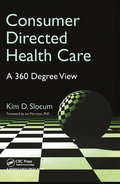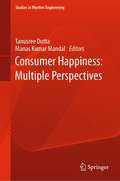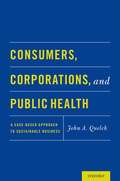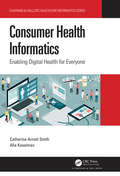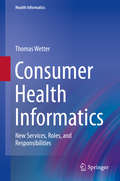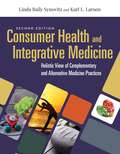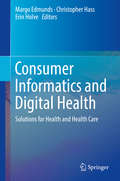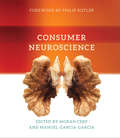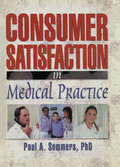- Table View
- List View
Constructing the Viennese Modern Body: Art, Hysteria, and the Puppet (Studies in Art Historiography)
by Nathan J. TimpanoThis book takes a new, interdisciplinary approach to analyzing modern Viennese visual culture, one informed by Austro-German theater, contemporary medical treatises centered on hysteria, and an original examination of dramatic gestures in expressionist artworks. It centers on the following question: How and to what end was the human body discussed, portrayed, and utilized as an aesthetic metaphor in turn-of-the-century Vienna? By scrutinizing theatrically “hysterical” performances, avant-garde puppet plays, and images created by Oskar Kokoschka, Koloman Moser, Egon Schiele and others, Nathan J. Timpano discusses how Viennese artists favored the pathological or puppet-like body as their contribution to European modernism.
Construction Safety: An Economic Analysis (Risk Engineering)
by Sun Wah Poon Rita Yi LiA close-to-ideal blend of suburb and city, speedy construction of towers of Babylon, the sparkling proportion of glass and steel buildings' facade at night showcase the wisdom of humans. They also witness the footsteps, sweats and tears of architects and engineers. Unfortunately, these signatures of human civilizations are swathed in towering figures of construction accidents. Fretting about these on sites, different countries adopt different measures on sites. This book firstly sketches the construction accidents on sites, followed by a review on safety measures in some of the developing countries such as Bermuda, Egypt, Kuwait and China; as well as developed countries, for example, the United States, France and Singapore. It also highlights the enormous compensation costs with the courts' experiences in the United Kingdom and Hong Kong.
Construction of the Self, Second Edition
by Susan Harter William M. BukowskiAn important work from a leading scholar, this book explores self-development from early childhood to adulthood. Susan Harter traces the normative stages that define the emergence of many self-processes, including self-esteem. She also addresses individual differences and societal influences on self-development. Presenting pioneering empirical research, Harter shows that increasingly mature features of the self have both benefits and liabilities for psychological adjustment. The book highlights the causes and consequences of different types of self-representations, including those that are unrealistically negative or positive. New to This Edition Reflects more than a decade of conceptual, empirical, and methodological advances. Provides a broader sociocultural framework for understanding self development. Chapters on emerging adulthood, self-esteem and physical appearance, self-processes in the classroom, motivation, cross-cultural issues, and the quest for authenticity. Expanded chapters on childhood, adolescence, and the self-conscious emotions, including humiliation. Increased attention to the liabilities of our contemporary preoccupation with the self.
Constructions of Cancer in Early Modern England: Ravenous Natures (Palgrave Studies in Literature, Science and Medicine)
by Alanna SkuseCancer is perhaps the modern world's most feared disease. Yet, we know relatively little about this malady's history before the nineteenth century. This book provides the first in-depth examination of perceptions of cancerous disease in early modern England. Looking to drama, poetry and polemic as well as medical texts and personal accounts, it contends that early modern people possessed an understanding of cancer which remains recognizable to us today. Many of the ways in which medical practitioners and lay people imagined cancer – as a 'woman's disease' or a 'beast' inside the body – remain strikingly familiar, and they helped to make this disease a byword for treachery and cruelty in discussions of religion, culture and politics. Equally, cancer treatments were among the era's most radical medical and surgical procedures. From buttered frog ointments to agonizing and dangerous surgeries, they raised abiding questions about the nature of disease and the proper role of the medical practitioner.
Constructions of Disability: Researching Inclusion in Community Leisure
by Claire TregaskisThis innovative book discusses the meaning of 'inclusion' through the exploration of the interactions between disabled and non-disabled people at a community leisure centre. By exploring the nature of this interface, an understanding of how people create potential for both disability and inclusion is revealed. This book takes a very different approach to that of existing texts, which have tended to concentrate mainly on disabled people's exclusion. The advantage of this new approach is that it adds an extra dimension to our understanding of how discriminatory practice is variously perpetuated and challenged..Constructions of Disability is valuable reading for all people who are working towards increased social inclusion for disabled people, including theorists and students of disability studies and learning difficulty, leisure management and disability service providers, and their families. Using a practical case study approach, it explores the impact that social interaction between disabled and non-disabled people can have increasing or decreasing disabled people's opportunities for inclusion. Examples of both inclusive and discriminatory practice are described in detail, and the positive and negative effects of these actions on the participants are demonstrated and discussed. This insightful book offers a wide range of practical suggestions for the future development of more inclusive theory, policy and practice.
Constructive Conversations About Health: Pt. 2, Perspectives on Policy and Practice
by Fritjof Capra Marshall MarinkerCurrent health policy is required to respond to a constantly changing social and political environment characterised, particularly in Europe, by ageing populations, increased migration, and growing inequalities in health and services. With health systems under increasing strain there is a sense that we need to seek new means of determining health policy. Much political debate focuses on managerial issues such as the levels of health funding and the setting and missing of targets. Meanwhile our moral imperatives, our values and principles, go relatively unexamined. What are these values? Can we agree their validity and salience? How do we manage the paradox of competing goods? Can we find new ways of talking about, and resolving, our conflicting values and competing priorities in order to create sound, appropriate, and just health policies for the 21st Century? Written by leading health policy makers and academics from many countries, "Constructive Conversations about Health" examines in depth the underlying values and principles of health policy, and posits a more enlightened public and political discourse. The book will be invaluable for those involved in health policy making and governance, politicians, healthcare managers, researchers, ethicists, health and social affairs media, health rights and patient participation groups. 'The literature on health policy is vast. On offer are models of health services, economic theory, management theory, disquisitions on ethical principles, social analyses, literally thousands of publications. In a globalised and electronically networked world, this literature has already generated its own particular language, a policy jargon replete with terms that look deceptively familiar, terms that will be much in evidence in what now follows, terms whose meanings require our closest attention.' - Marshall Marinker.
Consultant in Crisis
by Alison RobertsDanger...deception...desire! Emergency physician Neil Fletcher didn't expect to see Kelly Drummond ever again, let alone attend an Urban Search and Rescue course with her. She abandoned him at the worst time of his life--and he's never been able to forgive her...or forget her. Then disaster strikes when a shopping mall collapses, and the USAR team is needed. Working together to save lives, Kelly and Fletch have to confront the truth about the past--about the secret Kelly has kept for so long--and about a passion neither can resist!
Consultation in Neurourology: A Practical Evidence-Based Guide
by Jacques Corcos Mikolaj PrzydaczThis book is aimed to bring the reader into the heart of the action of any health professional consulted for a patient with a neurogenic bladder (NB). Extensive textbooks of the NB exist but there is a lack of an actual practical guide for diagnosis and management of patients suffering from NB. This book provides a single source of information on consultation in neurourology. The text covers both urinary incontinence and retention resulting from NB dysfunction. The book also discusses complications of NB which include urinary tract infections, hydronephrosis, renal failure or autonomic dysreflexia. Sections address these clinical issues faced by physicians. This book provides a useful guide with comprehensive and practical instructions for all practitioners dealing with NB in their day-to-day clinical practice. It will serve as a valuable resource for those with a special interest in NB. The book reviews new data about diagnostic and management options. It also provides a concise yet comprehensive summary of the current NB guidelines from different societies. All chapters include the most up to date scientific and clinical information with the relevant level of clinical evidence and grade of recommendation.
Consulting Hematology and Oncology Handbook
by Gustavo Rivero Iberia Romina SosaThis book aims to create consensus among hematology and oncology faculty in the guidance of trainees during their busy hematology/oncology inpatient months. A large number of questions frequently asked by medical students, residents and fellows prompted the creation of this handbook to assist in development of educational enduring guidelines. These guidelines greatly facilitate organization of inpatient hematologic malignancies units by improving trainees’ education. The handbook addresses unmet need to harmonize diagnostic procedures and therapy recommendations for complications observed in patients diagnosed with leukemia, lymphoma and myeloma. Along with an emphasis in malignant hematology, this handbook integrates common benign hematology and solid tumor emergencies chapters that complement trainees and practitioners understanding of complex and common inpatient consults. Quick implementation of recommendations is achieved by availability of algorithms and tables. Treatment of hemopoietic malignancies such as leukemia and lymphoma is challenging. Medical students, residents and hematology/oncology fellows face difficulties in understanding how to manage complex leukemia, lymphoma, and oncology cases during their rotations in hematologic malignant units. This handbook is designed to address routine questions that trainees frequently confront dealing with: (1) How to diagnose acute myelogenous leukemia [AML], and lymphoma; (2) Acute AML and lymphoma complications; and (3) Post chemotherapy adverse outcomes. The primary objective of this handbook is to facilitate not only rapid guidance into diagnosis and recognition of complications, but also provide standard of care/high quality direction for management. Trainees will benefit from worked examples in the text, problems for students, and solutions to these problems, as well.
Consulting im Gesundheitswesen: Professional Services als Gestaltungsimperative der Unternehmensberatung
by Mario A. Pfannstiel Christoph Rasche Andrea Braun von Reinersdorff Bianka Knoblach Dietmar FinkUnternehmensberatungen stellen mit ihrem Leistungsportfolio einen bedeutenden Wirtschaftsfaktor dar. Die digitale Transformation und die sehr spezifischen Marktstrukturen der Gesundheitswirtschaft verlangen nach differenzierten Beratungsansätzen, die zugleich ein großes Beratungsfeld eröffnen und so das Wachstum und die Attraktivität von Unternehmensberatungen in diesem Segment stärken. Das Buch zeigt Themenfelder und Erfolgsfaktoren bei Beratungsprojekten auf. Dabei wird der Ansatz der Komplementärberatung in den Mittelpunkt gestellt, um den vielfältigen Change-Anforderungen bei der digitalen Transformation im Gesundheitswesen ganzheitlich gerecht zu werden.Beratungsprojekte lassen sich in Meilensteine unterteilen, um Projektfortschritte zu dokumentieren. Durch Maßnahmen und den Einsatz von etablierten Methoden lassen sich festgelegte Ziele beim Beratungsgeschäft erreichen. Die Beiträge in diesem Buch präsentieren zahlreiche Umsetzungsbeispiele aus konkreten Beratungsprojekten in der Gesundheitsbranche, die Beratern, Geschäftsführern, Top-Managern und anderen Entscheidungsträgern praktische Hilfestellungen und Inspirationen bieten.
Consulting in a Nutshell: A practical guide to successful general practice consultations before, during and beyond the MRCGP
by Roger Neighbour‘…a unique book, written by a unique GP. There is no-one better placed to pull together decades of learning and experience on how to achieve the greatest success in the general practice consultation. The relaxed pace of writing, the accessible examples, the clear narrative and the engaging anecdotes make this a resource that it is accessible and useful to all who seek to improve their clinical consulting skills.’ Helen Stokes-Lampard, former Chair of the Royal College of General Practitioners This brand-new book aims to help GPs establish ways of thinking, talking and behaving in the consultation that are most likely to lead to good outcomes. It describes a simple three-part approach to the consultation’s essential task, which is to convert a patient’s problem into a plan acceptable to both patient and doctor. It combines reader-friendly explanations, helpful illustrations and examples from everyday practice. Key features: Written by a respected GP, teacher, and author of the highly-regarded trilogy The Inner Consultation, The Inner Apprentice and The Inner Physician Gives GPs a framework for consulting that is easy to remember, comprehensive, adaptable, robust, exam-friendly and quickly becomes second nature Identifies and addresses key areas of anxiety for GP trainees and MRCGP candidates, including ‘How do I complete in 10 minutes?’, ‘How do I deal with difficult patients?’ and ‘What do I do when it all goes pear-shaped and I don’t know what to do?’ Gives advice and practical suggestions for how to make the difficult transition from theory to practice, from reading about the consultation to actually doing it better in real life Consulting in a Nutshell will help GPs at every career stage – from medical student to CSA candidate to experienced practitioner – to analyse, develop and grow their personal consulting style. Coming at a time of profound change in primary care, it aims to ensure that seeing patients and having good consultations becomes and remains a source of satisfaction and fulfilment. The author:Roger Neighbour is a retired GP, former Convenor of the Panel of MRCGP Examiners, and past President, Royal College of General Practitioners, UK.
Consulting in a Nutshell: A practical guide to successful general practice consultations before, during and beyond the MRCGP
by Roger NeighbourPraise for the first edition: ‘…a unique book, written by a unique GP. There is no one better placed to pull together decades of learning and experience on how to achieve the greatest success in the general practice consultation. The relaxed pace of writing, the accessible examples, the clear narrative and the engaging anecdotes make this a resource that is accessible and useful to all who seek to improve their clinical consulting skills.’ Helen Stokes-Lampard, former Chair of the Royal College of General Practitioners ‘Excellent and easy to remember structure; this is the approach I’ll use daily.’ GP ST3 The second edition of this well-received book, fully revised to reflect changes to the RCGP Membership examination, helps GPs to establish ways of thinking, talking and behaving in the consultation that are most likely to lead to good outcomes. It describes a simple three-part approach to the consultation’s essential task, which is to convert a patient’s problem into a plan acceptable to both patient and doctor. It combines reader-friendly explanations, helpful illustrations and examples from everyday practice. Consulting in a Nutshell will help GPs at every career stage – from medical student to SCA candidate to experienced practitioner – to analyse, develop and grow their personal consulting style. At a time of ongoing and profound change in primary care, it aims to ensure that seeing patients and having good consultations becomes and remains a source of satisfaction and fulfilment.
Consulting with NLP: Neuro-Linguistic Programming in the Medical Consultation
by Lewis WalkerThis extraordinary and practical book examines neuro linguistic programming (NLP) - the knowledge and skills to detect and affect thinking patterns - and applies it to each phase of the medical consultation. It outlines the NLP tools most useful to physicians who wish to understand and utilise the dynamic structure underlying the processes used by excellent communicators. It explains how improving communication skills and developing new models of consultation to incorporate into daily practice not only helps healthcare professionals become better communicators, but reassures patients, alleviating suffering and promoting healing. This book provides many case examples and includes skill based exercises to ensure easy and effective learning. There are unique, fresh perspectives on challenging areas such as anger and aggression, dealing with complaints, breaking bad news, the heartsink patient, uncovering hidden depression and telephone consulting skills. It is relevant to all healthcare professionals, and of special interest to general practitioners, GP trainers, counsellors and medical students.
Consults in Obstetric Anesthesiology
by Suzanne K. MankowitzThis text addresses the need for a book specifically aimed at obstetric anesthesia and covers topics such as pulmonary, cardiac renal, hepatic, hematologic, neurologic, endocrine and other diseases. The real anesthetic challenge arises when patients present to Labor and Delivery with unusual or complicated medical problems and, in recent years, a few of the larger institutions have developed an Obstetric Anesthesiology Consultation Service to prepare for the management of these patients. While most pregnant women who present to Labor and Delivery require anesthetic intervention, they typically meet the anesthesiologist for the first time in labor. Since the majority of laboring women are healthy without significant comorbidities, this does not present much of a challenge to the anesthesiologist and the anesthetic management tends to be straight-forward with favorable outcomes. However, using this new model, the anesthesiologist has the opportunity to discuss the various treatment modalities and potentially suggest diagnostic testing to be performed prior to delivery, similar to the pre-operative testing that is done in other surgical environments.
Consumer Attitudes Toward Data Breach Notifications and Loss of Personal Information
by Paul Heaton Lillian Ablon Sasha Romanosky Diana Catherine LaveryAlthough spending on cybersecurity continues to grow, companies, government agencies, and nonprofit organizations are still being breached, and sensitive personal, financial, and health information is still being compromised. This report sets out the results of a study of consumer attitudes toward data breaches, notifications that a breach has occurred, and company responses to such events.
Consumer Directed Health Care: A 360 Degree View
by Kim SlocumWith three decades of experience in a variety of healthcare, pharmaceutical, and biotechnology firms, respected healthcare consultant, Kim Slocum applies a uniquely broad viewpoint to the U.S. healthcare crisis. He discusses how the system has evolved and debunks various myths that continue to persist. Exploring potential solutions, he balances many diverse and conflicting factors, including the movement to make healthcare more patient-centered and the growing trend to transfer significant portions of financial risk to patients via high-deductibles. Slocum closes the book by discussing what a successful consumer-directed system might look like and what steps would be required to make it happen.
Consumer Genetic Technologies: Ethical and Legal Considerations
by Henry T. Greely I. Glenn Cohen Carmel Shachar Nita A. FarahanyFor the average person, genetic testing has two very different faces. The rise of genetic testing is often promoted as the democratization of genetics by enabling individuals to gain insights into their unique makeup. At the same time, many have raised concerns that genetic testing and sequencing reveal intensely personal and private information. As these technologies become increasingly available as consumer products, the ethical, legal, and regulatory challenges presented by genomics are ever looming. Assembling multidisciplinary experts, this volume evaluates the different models used to deliver consumer genetics and considers a number of key questions: How should we mediate privacy and other ethical concerns around genetic databases? Does aggregating data from genetic testing turn people into products by commercializing their data? How might this data reduce or exacerbate existing healthcare disparities? Contributing authors also provide guidance on protecting consumer privacy and safety while promoting innovation.
Consumer Happiness: Multiple Perspectives (Studies in Rhythm Engineering)
by Tanusree Dutta Manas Kumar MandalThis book helps quench the quest of knowledge of academicians, researchers, and others interested in developing a complete and critical understanding of consumer happiness. The relentless search of happiness by humans is sought in different ways. Scientific discussion on happiness for long was considered a forte of Philosophers. Other disciplines seldom delved into this. But today not only science but neuroscience, marketing, and other varied fields have started delving into it and have developed a keen interest. The book has been conceptualized on this line of thinking and thus divided into two parts. The first part is customized towards understanding various perspectives of happiness and the relative importance of knowing the same. The first chapter of this section is on the biological perspective of happiness. The second is titled ‘Behavioural perspective’. The third chapter is an attempt to elucidate the cultural perspective of the concept of happiness. The fourth is on the role of technology in inducing happiness. Fifth and sixth are on theories of happiness and measuring happiness, respectively. Knowledge about the different perspective and theories has a wide range of benefits. It informs us about how the brain works, interprets, and reacts. This theoretical understanding helps us to move beyond the trial and error methods towards a more scientific underpinning of adoption of measures that would generate long-lasting happiness in consumers.The second part of the book is dedicated toward understanding consumer happiness from a neuroscience perspective, i.e. keeping consumer happy. This segment has ten chapters. The first is on differentiating the concept of happiness from satisfaction. The second is on sensory marketing and happiness. The third deals with the store design and shelving of products to generate happiness. Fourth and fifth chapters relate to persuading the consumers. While the fourth chapter is on developing persuasive messages and the fifth is on subliminal messaging sixth chapter is on pricing and seventh on advertising. The eighth chapter highlights the role of emotions and the ninth is on the different factors that induce happiness in consumers. The last chapter is about raising some unanswered questions and food for thought for readers. Together the contents of the book make for a complete understanding of the concept of happiness and how it is shaping the world of marketing. Addressing the ‘what’ and ‘how’ of consumer happiness in the same book makes the book comprehensive.
Consumer Health
by John A. Quelch Emily C. BoudreauThe public health footprint associated with corporate behavior has come under increased scrutiny in the last decade, with an increased expectation that private profit not come at the expense of consumer welfare. Consumers, Corporations, and Public Health assembles 17 case studies at the intersection of business and public health to illustrate how each side can inform and benefit the other. Through contemporary examples from a variety of industries and geographies, this collection provides students with an appreciation for the importance of consumer empowerment and consumer behavior in shaping both health and corporate outcomes.
Consumer Health Informatics: Enabling Digital Health for Everyone (Chapman & Hall/CRC Healthcare Informatics Series)
by Catherine Arnott Smith Alla Keselman"An engaging introduction to an exciting multidisciplinary field where positive impact depends less on technology than on understanding and responding to human motivations, specific information needs, and life constraints." -- Betsy L. Humphreys, former Deputy Director, National Library of Medicine This is a book for people who want to design or promote information technology that helps people be more active and informed participants in their healthcare. Topics include patient portals, wearable devices, apps, websites, smart homes, and online communities focused on health. Consumer Healthcare Informatics: Enabling Digital Health for Everyone educates readers in the core concepts of consumer health informatics: participatory healthcare; health and e-health literacy; user-centered design; information retrieval and trusted information resources; and the ethical dimensions of health information and communication technologies. It presents the current state of knowledge and recent developments in the field of consumer health informatics. The discussions address tailoring information to key user groups, including patients, consumers, caregivers, parents, children and young adults, and older adults. For example, apps are considered as not just a rich consumer technology with the promise of empowered personal data management and connectedness to community and healthcare providers, but also a domain rife with concerns for effectiveness, privacy, and security, requiring both designer and user to engage in critical thinking around their choices. This book’s unique contribution to the field is its focus on the consumer and patient in the context of their everyday life outside the clinical setting. Discussion of tools and technologies is grounded in this perspective and in a context of real-world use and its implications for design. There is an emphasis on empowerment through participatory and people-centered care.
Consumer Health Informatics: New Services, Roles, and Responsibilities (Health Informatics)
by Thomas WetterThis book offers demographic analysis, client appraisal, trial design, etc along with many examples to inform the conception and critical evaluation of consumer health informatics services. Patient safety, legal and ethical appraisal, and business models add to the systematic coverage. Regarding longevity and increase of chronic diseases traditional medical care faces tremendous financial and human resource problems. Is self-service medicine as follow up of traditional care or as an approach in its own right the answer? Are internet and app stores the place where self service medicine takes place? The book distinguishes stages of such an endeavour.
Consumer Health and Integrative Medicine: Holistic View of Complementary and Alternative Medicine Practices
by Linda Baily Synovitz Karl L. LarsonToday, being a health consumer encompasses more than being knowledgeable about traditional medicine and health practice but also includes the necessity to be well informed about the expanding field of complementary and alternative medicine. This book was written to expand upon the many alternative modalities that many other consumer health texts overlook. It includes chapters on the major alternative medicine systems and healing modalities, including Ayurvedic medicine, traditional Chinese medicine, naturopathy, homeopathic medicine, chiropractic medicine, massage, reflexology, and herbals or botanicals. <p><p> The authors mission is to increase reader's knowledge base, not make up their mind, as we all make better choices related to our own personal health care practices when we are informed consumers.
Consumer Informatics and Digital Health: Solutions For Health And Health Care
by Margo Edmunds Christopher Hass Erin HolveThis unique collection synthesizes insights and evidence from innovators in consumer informatics and highlights the technical, behavioral, social, and policy issues driving digital health today and in the foreseeable future. Consumer Informatics and Digital Health presents the fundamentals of mobile health, reviews the evidence for consumer technology as a driver of health behavior change, and examines user experience and real-world technology design challenges and successes. Additionally, it identifies key considerations for successfully engaging consumers in their own care, considers the ethics of using personal health information in research, and outlines implications for health system redesign. The editors’ integrative systems approach heralds a future of technological advances tempered by best practices drawn from today’s critical policy goals of patient engagement, community health promotion, and health equity. Here’s the inside view of consumer health informatics and key digital fields that students and professionals will find inspiring, informative, and thought-provoking.
Consumer Neuroscience (The\mit Press Ser.)
by Moran Cerf Manuel Garcia-GarciaA comprehensive introduction to using the tools and techniques of neuroscience to understand how consumers make decisions about purchasing goods and services.Contrary to the assumptions of economists, consumers are not always rational actors who make decisions in their own best interests. The new field of behavioral economics draws on the insights of psychology to study non-rational decision making. The newer field of consumer neuroscience draws on the findings, tools, and techniques of neuroscience to understand how consumers make judgments and decisions. This book is the first comprehensive treatment of consumer neuroscience, suitable for classroom use or as a reference for business and marketing practitioners.After an overview of the field, the text offers the background on the brain and physiological systems necessary for understanding how they work in the context of decision making and reviews the sensory and perceptual mechanisms that govern our perception and experience. Chapters by experts in the field investigate tools for studying the brain, including fMRI, EEG, eye-tracking, and biometrics, and their possible use in marketing. The book examines the relation of attention, memory, and emotion to consumer behavior; cognitive factors in decision making; and the brain's reward system. It describes how consumers develop implicit associations with a brand, perceptions of pricing, and how consumer neuroscience can encourage healthy behaviors. Finally, the book considers ethical issues raised by the application of neuroscience tools to marketing.ContributorsFabio Babiloni, Davide Baldo, David Brandt, Moran Cerf, Yuping Chen, Patrizia Cherubino, Kimberly Rose Clark, Maria Cordero-Merecuana, William A. Cunningham, Manuel Garcia-Garcia, Ming Hsu, Ana Iorga, Philip Kotler, Carl Marci, Hans Melo, Kai-Markus Müller, Brendan Murray, Ingrid L. C. Nieuwenhuis, Graham Page, Hirak Parikh, Dante M. Pirouz, Martin Reimann, Neal J. Roese, Irit Shapira-Lichter, Daniela Somarriba, Julia Trabulsi, Arianna Trettel, Giovanni Vecchiato, Thalia Vrantsidis, Sarah Walker
Consumer Satisfaction in Medical Practice
by William Winston Paul A SommersConsumer Satisfaction in Medical Practice will equip physicians and other decision makers in health care with the necessary tools to meet the growing demand for customers’satisfaction in medical practices. Addressing the deliverance of accurate and affective medical services, this intelligent guide provides you with proven techniques in order to provide competitive prices, convenience, accessibility, and quality outcomes to customers. Consumer Satisfaction in Medical Practice turns the delivery of health care toward the patient. Each recommendation will enable you to provide long-term and cost-effective benefits for customers and your company. Exposing common myths about medical practice, this knowledgeable book offers you a patient’s perspective on the services they need and request to help you offer your customers the appropriate services. From Consumer Satisfaction in Medical Practice, you will be able to give customers the medical services they want with the help of proven methods and suggestions which include: remembering that office budgets, profits for practitioners, and financial strengths of progressive hospitals and physician service organizations exist to help offer better health services to customers creating a consumers’bill of rights that ensures patients that they are receiving the best possible care for their money, that every patient has a right to their own medical information, and that every patient has a right to express grievances sending out newsletters and announcements of staff changes and changes to office hours to improve physician services to patients incorporating consumer satisfaction in employee and physician performance evaluations and setting standards for consumer satisfaction measuring physician staff and employee satisfaction along with that of the patient and payer to improve provider conditions and consumer satisfaction increasing physician satisfaction by recognition through awards and an incentive systemFeaturing several charts, tables, and suggestion boxes, this guide contains effective steps that you can institute in order to offer excellent care to your customers. Consumer Satisfaction in Medical Practice allows you to expand and improve customer satisfaction for the benefit of your customers and your business.

